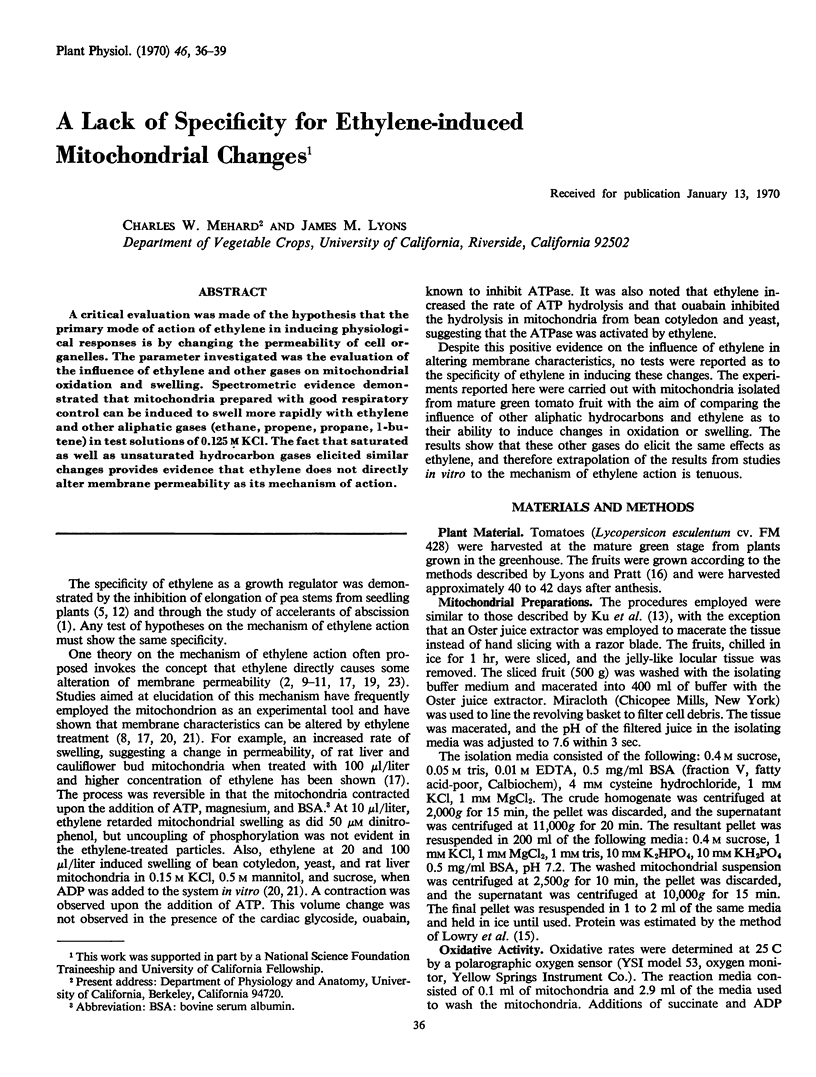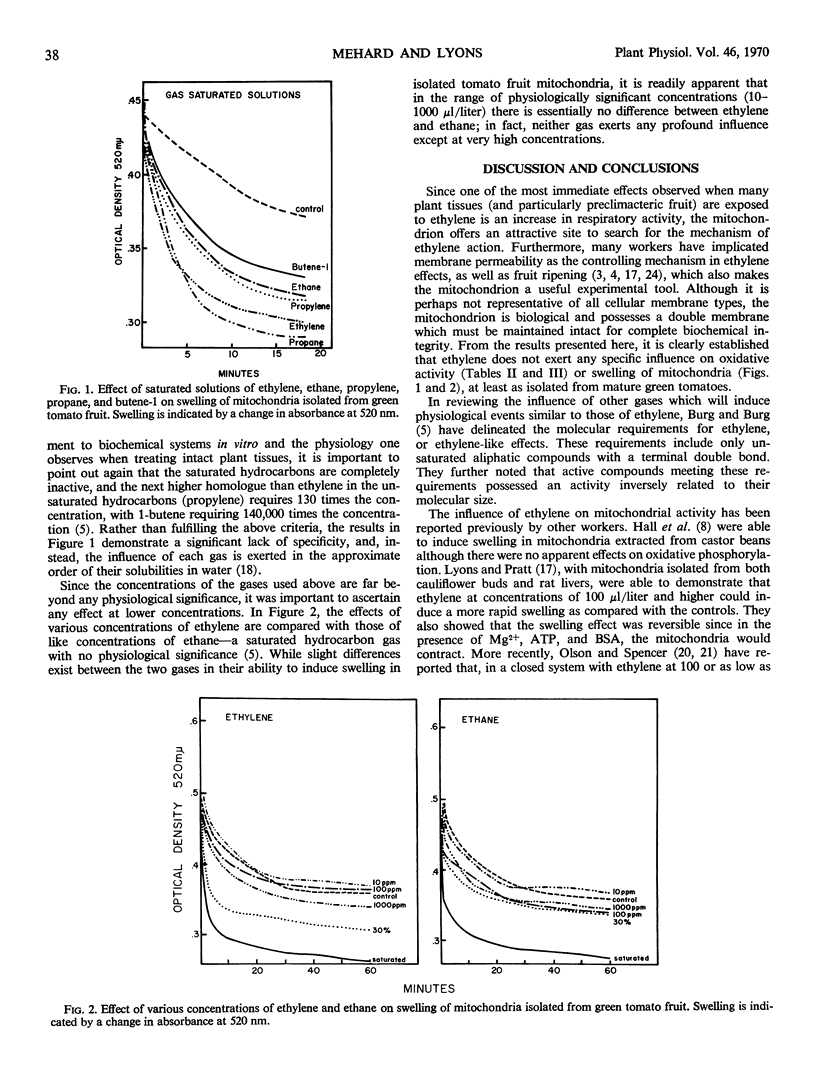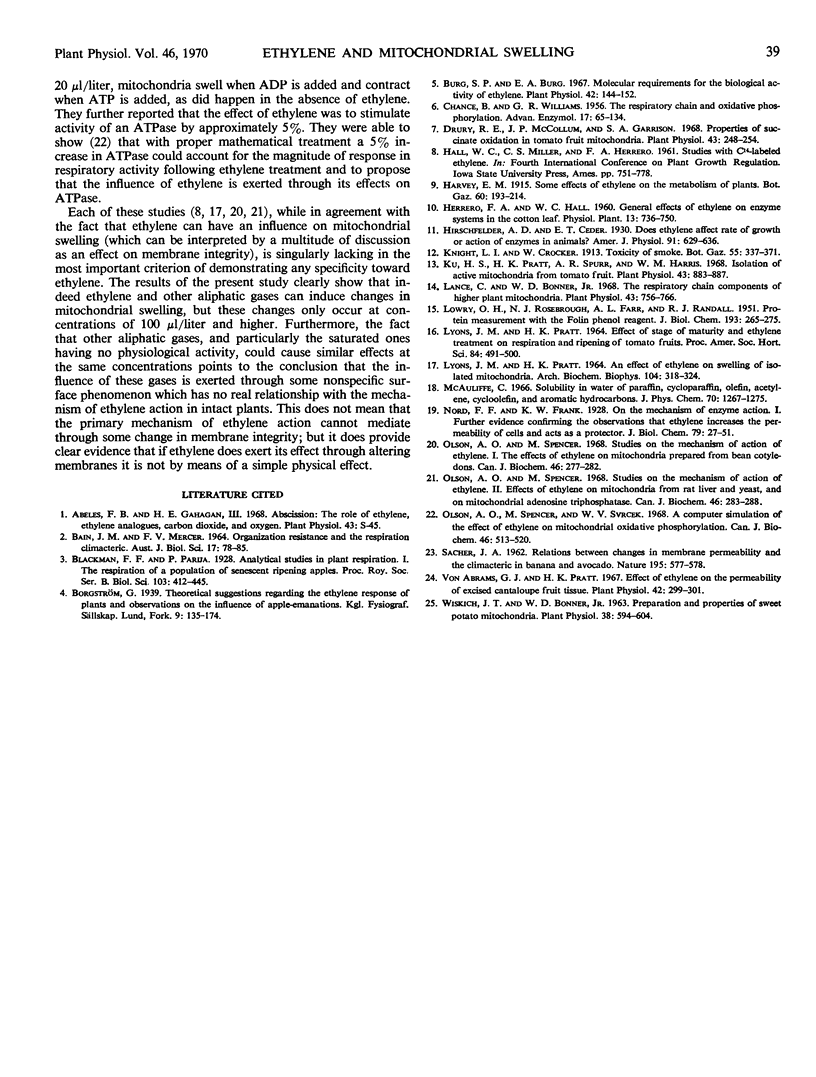Abstract
A critical evaluation was made of the hypothesis that the primary mode of action of ethylene in inducing physiological responses is by changing the permeability of cell organelles. The parameter investigated was the evaluation of the influence of ethylene and other gases on mitochondrial oxidation and swelling. Spectrometric evidence demonstrated that mitochondria prepared with good respiratory control can be induced to swell more rapidly with ethylene and other aliphatic gases (ethane, propene, propane, I-butene) in test solutions of 0.125 m KCl. The fact that saturated as well as unsaturated hydrocarbon gases elicited similar changes provides evidence that ethylene does not directly alter membrane permeability as its mechanism of action.
Full text
PDF



Selected References
These references are in PubMed. This may not be the complete list of references from this article.
- AVon Abrams G. J., Pratt H. K. Effect of ethylene on the permeability of excised cantaloupe fruit tissue. Plant Physiol. 1967 Feb;42(2):299–301. doi: 10.1104/pp.42.2.299. [DOI] [PMC free article] [PubMed] [Google Scholar]
- Burg S. P., Burg E. A. Molecular requirements for the biological activity of ethylene. Plant Physiol. 1967 Jan;42(1):144–152. doi: 10.1104/pp.42.1.144. [DOI] [PMC free article] [PubMed] [Google Scholar]
- CHANCE B., WILLIAMS G. R. The respiratory chain and oxidative phosphorylation. Adv Enzymol Relat Subj Biochem. 1956;17:65–134. doi: 10.1002/9780470122624.ch2. [DOI] [PubMed] [Google Scholar]
- Drury R. E., McCollum J. P., Garrison S. A. Properties of succinate oxidation in tomato fruit mitochondria. Plant Physiol. 1968 Feb;43(2):248–254. doi: 10.1104/pp.43.2.248. [DOI] [PMC free article] [PubMed] [Google Scholar]
- Ku H. S., Pratt H. K., Spurr A. R., Harris W. M. Isolation of active mitochondria from tomato fruit. Plant Physiol. 1968 Jun;43(6):883–887. doi: 10.1104/pp.43.6.883. [DOI] [PMC free article] [PubMed] [Google Scholar]
- LOWRY O. H., ROSEBROUGH N. J., FARR A. L., RANDALL R. J. Protein measurement with the Folin phenol reagent. J Biol Chem. 1951 Nov;193(1):265–275. [PubMed] [Google Scholar]
- LYONS J. M., PRATT H. AN EFFECT OF ETHYLENE ON SWELLING OF ISOLATED MITOCHONDRIA. Arch Biochem Biophys. 1964 Feb;104:318–324. doi: 10.1016/s0003-9861(64)80020-5. [DOI] [PubMed] [Google Scholar]
- Lance C., Bonner W. D. The respiratory chain components of higher plant mitochondria. Plant Physiol. 1968 May;43(5):756–766. doi: 10.1104/pp.43.5.756. [DOI] [PMC free article] [PubMed] [Google Scholar]
- Olson A. O., Spencer M. Studies on the mechanism of action of ethylene. I. The effects of ethylene on mitochondria prepared from beam cotyledons. Can J Biochem. 1968 Mar;46(3):277–282. doi: 10.1139/o68-040. [DOI] [PubMed] [Google Scholar]
- Olson A. O., Spencer M. Studies on the mechanism of action of ethylene. II. Effects of ethylene on mitochondria from rat liver and yeast, and on mitochondrial adenosine triphosphatase. Can J Biochem. 1968 Mar;46(3):283–288. doi: 10.1139/o68-041. [DOI] [PubMed] [Google Scholar]
- Olson A. O., Spencer M., Surcek W. V. A computer simulation of the effect of ethylene on mitochondrial oxidative phosphorylation. Can J Biochem. 1968 Jun;46(6):513–520. doi: 10.1139/o68-080. [DOI] [PubMed] [Google Scholar]
- Wiskich J. T., Bonner W. D. Preparation and Properties of Sweet Potato Mitochondria. Plant Physiol. 1963 Sep;38(5):594–604. doi: 10.1104/pp.38.5.594. [DOI] [PMC free article] [PubMed] [Google Scholar]


